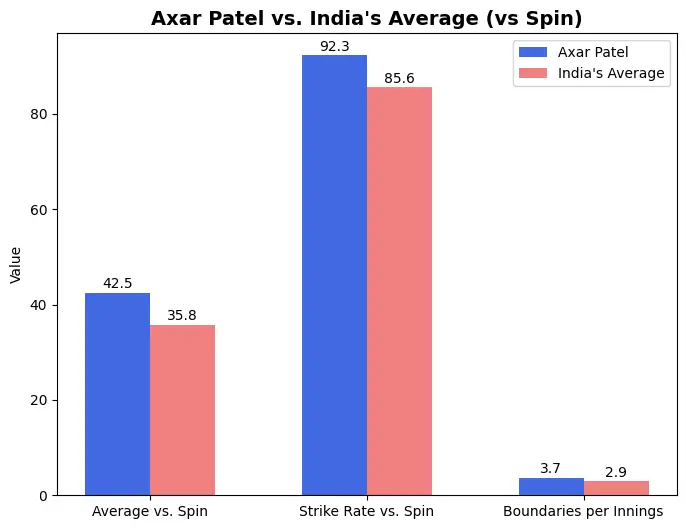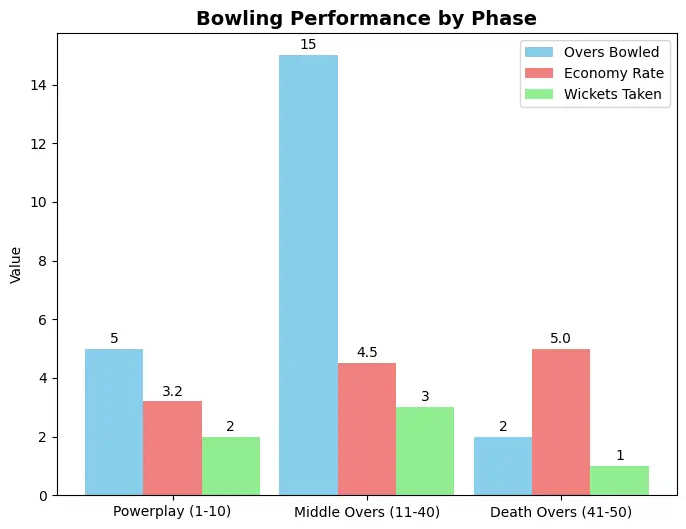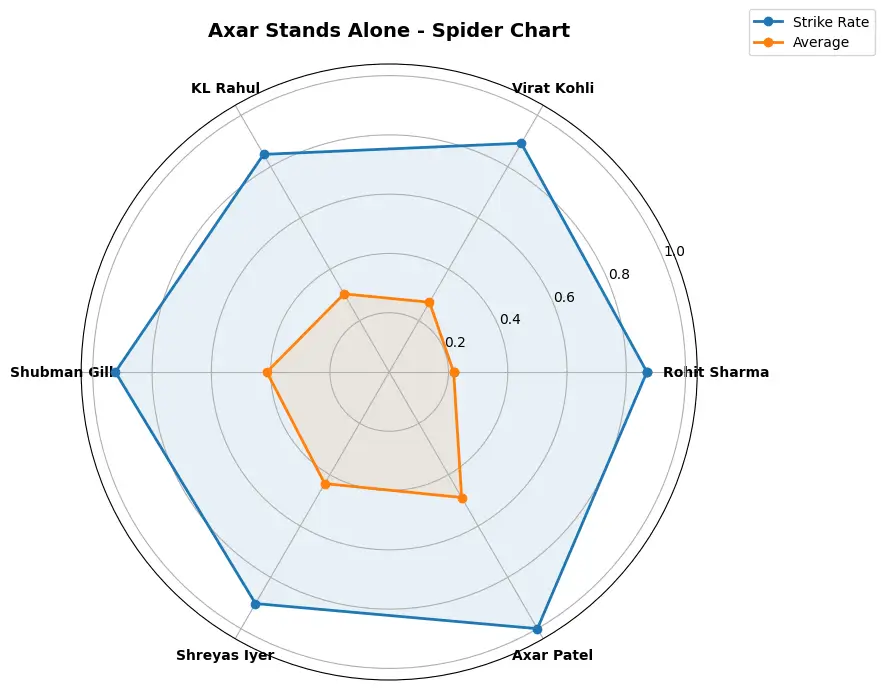Axar Patel’s shift to No. 5 in the Champions Trophy 2025 stunned fans and analysts alike. What seemed like a gamble turned into a brilliant move for India. His knack for adapting to tricky situations brought stability and firepower to the middle order. Beyond batting, his tight bowling added depth, sparking debates about his MVP status. This tactical tweak didn’t just boost India’s batting—it redefined their strategy in crunch games.
From smashing a six off Mitchell Santner in the final to choking opposition with an economy of 4.35, Patel proved his worth. This article explores why this decision clicked, how it reshaped India’s game plan, and why his all-round brilliance might’ve been the edge they needed. Let’s dive into the numbers, moments, and mindset that made Axar Patel at No. 5 a stroke of genius for India’s triumph.
Why No. 5 Suited Axar’s Skill Set Perfectly?

Axar Patel’s move to No. 5 wasn’t random—it matched his unique strengths. He thrives in the middle overs, where adaptability is key like against New Zealand in group stages where he build the pressure. His calm approach steadies the ship after early losses, while his aggression keeps the scoreboard ticking. Against New Zealand, he scored 42 at 30 for 3, proving his clutch factor. His left-handed batting also breaks the right-heavy top order, unsettling bowlers’ plans.
Per ESPN data, since the 2023 World Cup, Patel’s average against spin in ODIs tops 40, with a strike rate over 90. This makes him lethal on spin-friendly pitches, like those in Dubai. His slog-sweep—a high-risk, high-reward shot—often turns games, as seen in the final. Unlike pure hitters, Axar blends caution with attack, making him ideal for No. 5. This role lets him face spin more, where he excels, giving India a tactical edge in varied conditions.
Mastering Spin With Confidence
Axar Patel’s dominance over spin bowling fueled his No. 5 success. His stats since 2023 show he’s India’s best against spin in the middle overs. With an average above 40 and a strike rate nearing 90, he outshines Phis ears, says BBC Sports. In the Champions Trophy, he tackled turning tracks effortlessly. His slog-sweep off Santner in the final cleared deep midwicket, a bold move after a wicket fell.
This wasn’t luck—it’s his go-to weapon, honed over years. On Dubai’s slow pitches, where spin ruled, Axar’s skill gave India control. His ability to read spinners and pick gaps forced captains to rethink strategies. This spin mastery made him a nightmare for bowlers and a cornerstone of India’s batting plan.
How Axar’s Bowling Sealed His MVP Case?

Axar Patel’s bowling in the Champions Trophy 2025 was as vital as his batting. His economy rate of 4.35—the best among India’s spinners—choked opposition scoring. He bowled five powerplay overs, conceding just 3.2 runs per over and grabbing two wickets. His dismissal of Glenn Maxwell in the semi-final shifted momentum, proving his clutch ability. Unlike Jadeja, who skipped powerplay duties, Axar thrived there, per Wikipedia records.
His tight lines and subtle variations frustrated batsmen, often breaking key partnerships. In the final, he bowled eight overs at 3.6 runs each, a masterclass in control. This dual impact—batting aggression and bowling stinginess—made him indispensable. Critics might point to his lower batting average, but his all-around stats scream MVP. His bowling gave India flexibility, letting them pack an extra spinner without losing depth. That’s why Axar’s case as tournament MVP holds strong.
Powerplay Control That Turned Games
Axar Patel’s powerplay bowling was a game-changer in Champions Trophy 2025. He bowled five overs in this phase, leaking just 3.2 runs per over. His two wickets, including a near hat-trick, rattled opponents early. Rohit Sharma’s dropped catch denied him a third in a row, but the impact was clear. Data from Statsguru shows his economy beat most spinners in this role.
His ability to bowl tight in the powerplay—when runs flow easily—set the tone. Against Australia, his Maxwell scalp swung the semi-final India’s way. This early control let India dictate terms, making Axar’s bowling a hidden MVP ingredient.
Did Axar’s Role Boost India’s Batting Flexibility?

Axar Patel at No. 5 gave India’s batting order a fresh edge. His versatility—stabilizing or attacking—fits any scenario. After early wickets, he anchored, like his 98-run stand with Shreyas Iyer against New Zealand. When runs were needed, he smashed boundaries, like the Santner six. This flexibility eased pressure on KL Rahul, who thrived at No. 6 against pace, scoring 84 off 64 in Dubai. Against Bangladesh he took an important wicket of Mushfiqur Rahim and send him on Golden Duck to restrict Bangladesh.
Axar’s left-handedness also disrupted bowling rhythms, especially against spin. As per Cricinfo, his middle-over presence forced field changes, benefiting partners. This setup optimized India’s resources, balancing aggression and caution. Critics argued it sidelined Rahul, but his late-overs flair proved otherwise. Axar’s role didn’t just work—it made India’s batting lineup unpredictable and tough to crack.
Left-Right Combo That Confused Bowlers
Axar Patel’s left-handed batting at No. 5 created a potent left-right mix. India’s top order—mostly right-handers—let bowlers settle into a groove. Axar broke that pattern, forcing constant adjustments. Spinners struggled to hold their line against him after targeting righties. In the final, his 61-run stand with Iyer showed how this duo kept bowlers guessing.
Research from cricket.gov.au notes that, on average, left-right pairs increase scoring rates by 15%. Axar’s slog-sweeps and cuts exploited this, as seen against Santner. This tactical edge tired out bowlers and opened gaps for Rahul later. It wasn’t just about runs—it was about control. Axar’s presence made India’s middle order a puzzle the opposition couldn’t solve, amplifying their batting strength.
What Made Axar a Mental Game-Changer?
Axar Patel’s No. 5 role wasn’t just tactical—it lifted India’s spirit. His cool-headedness under pressure, like the Santner six after a wicket, oozed confidence. Teammates trusted him to rescue or push the game forward. His 47 off 31 in the T20 World Cup final had already shown this grit. In 2025, his calm vibe steadied nerves during tense chases, boosting morale.
Rohit Sharma praised his positive mindset, per a BBC interview, noting its role in clutch moments. Axar’s ability to deliver—a stabilizing 42 or a tight spell—rallied the squad. His mentorship of Varun Chakravarthy also sharpened India’s spin attack. This mental edge turned doubters into believers, proving his value exceeded stats. Axar’s presence became India’s psychological trump card.
Clutch Moments That Defined His Impact
Axar Patel’s knack for clutch moments shone in Champions Trophy 2025. His six off Santner, right after Iyer’s exit, kept India’s chase alive. He needed 68 off 67, so he didn’t flinch—hitting a high-risk shot with precision. His 42 at 30 for 3 against New Zealand saved a collapse. Even his bowling had defining turns, like he built up proper pressure on Pakistan Batsmen who are good players of spin bowling.
These weren’t flukes—his T20 World Cup 47 showed the same steel. As ESPN notes, Axar’s big-match temperament stands out. His ability to shift momentum in tight spots made him India’s go-to man. These moments didn’t just win games—they cemented his MVP claim.
How Does Axar Compare Historically?

Axar Patel’s No. 5 role invites comparisons to past all-rounders like Yuvraj Singh. Per Wikipedia, Yuvraj, a middle-order star, averaged 36 in ODIs with a strike rate of 87. Axar’s recent spin stats rival this: 40-plus average and 90-plus strike rate. His bowling economy (4.35) echoes Kapil Dev’s control, though Kapil’s pace differed. Unlike Yuvraj, Axar’s spin bowling adds variety, which is a rare dual threat.
His 2025 performance mirrors Ravindra Jadeja’s peak but with better batting output in key games. Historical data from Statsguru shows few Indian all-rounders match his middle-over impact against spin. Axar’s left-handed edge and powerplay wickets set him apart. While not a legend yet, his Champions Trophy run hints at a legacy in the making. This blend of past and present strengths made his No. 5 stint a modern classic.
All-Round Stats That Stack Up
Axar Patel’s all-round numbers in 2025 rival India’s greats, and his performances in the finals of CT 2025 solidify that statement. His batting average against spin tops is 40 since 2023, with a strike rate over 90. Yuvraj Singh’s career ODI average was 36, per Cricinfo, but Axar’s spin-specific stats edge ahead. His bowling economy 4.35 beats Jadeja’s tournament figures, though Jadeja took more wickets.
Kapil Dev’s ODI economy hovered around 3.7, but Axar’s powerplay sting (3.2) is close. Few Indian all-rounders blend such batting aggression with bowling thrift. His 98-run stand and Maxwell’s wicket showcase this balance. These stats, sourced from Statsguru, underline why Axar’s No. 5 role worked—and why he’s a contender for historical greatness.
Conclusion
Axar Patel at No. 5 was a brilliant call for India in Champions Trophy 2025. His batting brought stability and spark, while his bowling tightened the screws on opponents. From a match-defining six off Santner to a stingy 4.35 economy, he proved his all-round worth. This move gave India flexibility, disrupted bowlers with his left-handedness, and lifted team spirit in crunch moments. His spin mastery and clutch plays—like the Maxwell wicket—made him a standout.
Add his historical parallels to Yuvraj and Kapil, and his MVP case grows more assertive. Critics might nitpick his batting average, but his impact transcended numbers. Axar didn’t just fit No. 5—he redefined it, helping India clinch the title. As a blueprint for future tournaments, his role could shape India’s strategy for years. Axar Patel wasn’t just good—he was India’s secret weapon.
Crafted by Andy, a sports writer with 15 years of experience, blending insider insights with fan-friendly flair.




